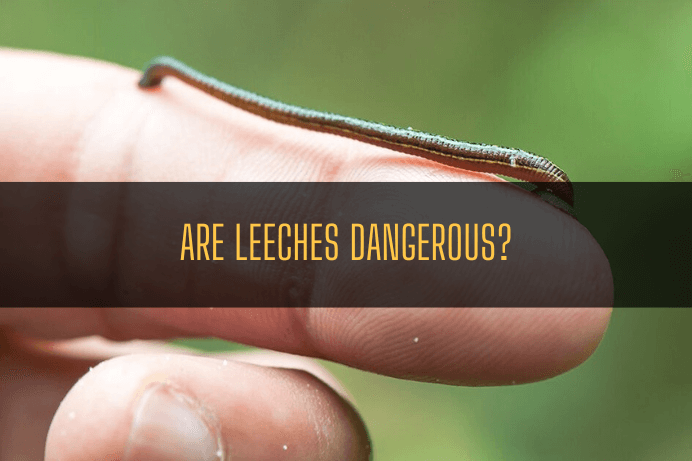Are Leeches Extremely Dangerous?
On Mother Earth, there are various sorts of creepy creatures; some are beautiful to observe, while others are frightening. A leech is one of the strange or impure things you can encounter in your lifetime.
Even though they seem minor, you get chills all over your body when you see something close to your skin. In essence, one will become uneasy around this tiny terrifying species.
Finding a leech on your body can be unnerving, but many are unsure if this species can damage people, given that they primarily rely on blood for survival. Why does this happen? Are leeches dangerous? In this essay, we shall learn the solution.
Chronology of Leech
Leeches are aquatic, worm-like organisms that are members of the subclass Hirudinea and phylum Annelida. These invertebrates, like the oligochaetes, such as the earthworm, are parasitic parasites that obtain their nourishment from hosts that are either humans or animals.
They have segmented, soft, musculoskeletal bodies that can stretch and shrink. The coelom, a sizable chamber in most annelids, has been reduced to microscopic channels, and the body appears elastic and quite substantial. Although most populations of leeches live in freshwater, some can also be found on land or at sea.
Are Leeches Dangerous?
Do leeches pose a threat? Leech bites frequently cause itching and purpura as symptoms. These tiny invertebrates pose little threat to humans. However, in rare instances, some people may experience allergic reactions to their bites. Anaphylaxis sufferers should use extra caution.
Additionally, prolonged bleeding after a bite is more frequent in people who use anticoagulant medications. Most leech bites are accidental deaths and are typically simple to remove without medical help. However, because leech saliva has anticoagulant characteristics that prevent normal blood coagulation, the bite may cause prolonged seeping at the attachment area when the Leech is removed.
Types of species of Leeches
There are more than 700 species of leeches, most of which are found in freshwater or grasslands. However, some can also be found in seawater.
How do they Feed?
Numerous leech species are sanguinivorous, which means they feed on blood. Once they’ve attached themselves to a person or animal, they eat their favorite meal and expand up to 10 times their original size when feeding, allowing them to consume a lot of blood at once.
How Can Leeches Be Removed?
The first step in getting rid of a leech is finding it. You could eliminate them quickly by following the easy techniques listed below.
- Locate the mouth and head: A leech’s head is slenderer and smaller than the rest of its body. Look for the Leech’s thinnest part of its body, which is the portion that comes into touch with your skin, to identify its mouth.
- Pull the skin taut under the Leech with one hand, then use your other hand to slide a fingernail under the Leech’s mouth and pull it out of your skin.
- Flick the Leech away to remove it: Flick it away with your fingertips before the Leech attaches.
- Ensure the wound is tidy: Cleanse your wound with denatured alcohol or a first-aid cleanser to prevent infection.
- Cover the wound with a bandage: The removal of the Leech will result in significant bleeding. Before covering the incision with a sterile bandage, could you clean it up? Change the bandage every few hours during the first several hours until the bleeding stops.
Leeches find their prey in what manner?
Leeches are generally nocturnal, although they are drawn to vibrations in water that generate disruptions. When more giant creatures swim by or when people splash during the sweltering heat, these water vibrations are set off.
Given their ability to swim, leeches surprisingly come out of concealment to attach themselves to their host and feed.
When their fangs pierce the host’s skin, an anesthetic enzyme that blocks reflex actions is quickly released. Additionally, the enzyme functions as an anticoagulant, facilitating easy blood flow from the host to the parasite.
The Leech consumes around five times its weight in blood from a host before these sea crustaceans drop off and return to their lair.
How Do You Spot a Leech?
Interestingly, worms and leeches have a close link. They are flat and, fascinatingly, vary in length depending on the species. Most of these sea critters are between 0.3 and 3 inches long. However, other species can reach lengths of 18 inches.
Most leeches have circular mouths with many rows of teeth and visible eyeballs on the top of their bodies. Additionally, they come in various hues and designs, such as spots, stripes, and dark hues. Two suckers are utilized to grip, eat, and move about on each end of their bodies.
Conclusion
Although leeches can be uncomfortable, they have been used for medical purposes for many years. It was assumed their ability to suction blood out of the body helped suck diseased blood out of sick patients.

